Critical Thinking and Managerial Decision-Making
VerifiedAdded on 2023/06/13
|8
|2289
|488
AI Summary
This paper covers the benefits of critical thinking, differences between critical thinking and automatic thinking, and tools to achieve clarity and reach the best conclusion. It also provides ways to influence and persuade people at the workplace, increase self-awareness, and make relevant decisions to be an effective leader.
Contribute Materials
Your contribution can guide someone’s learning journey. Share your
documents today.
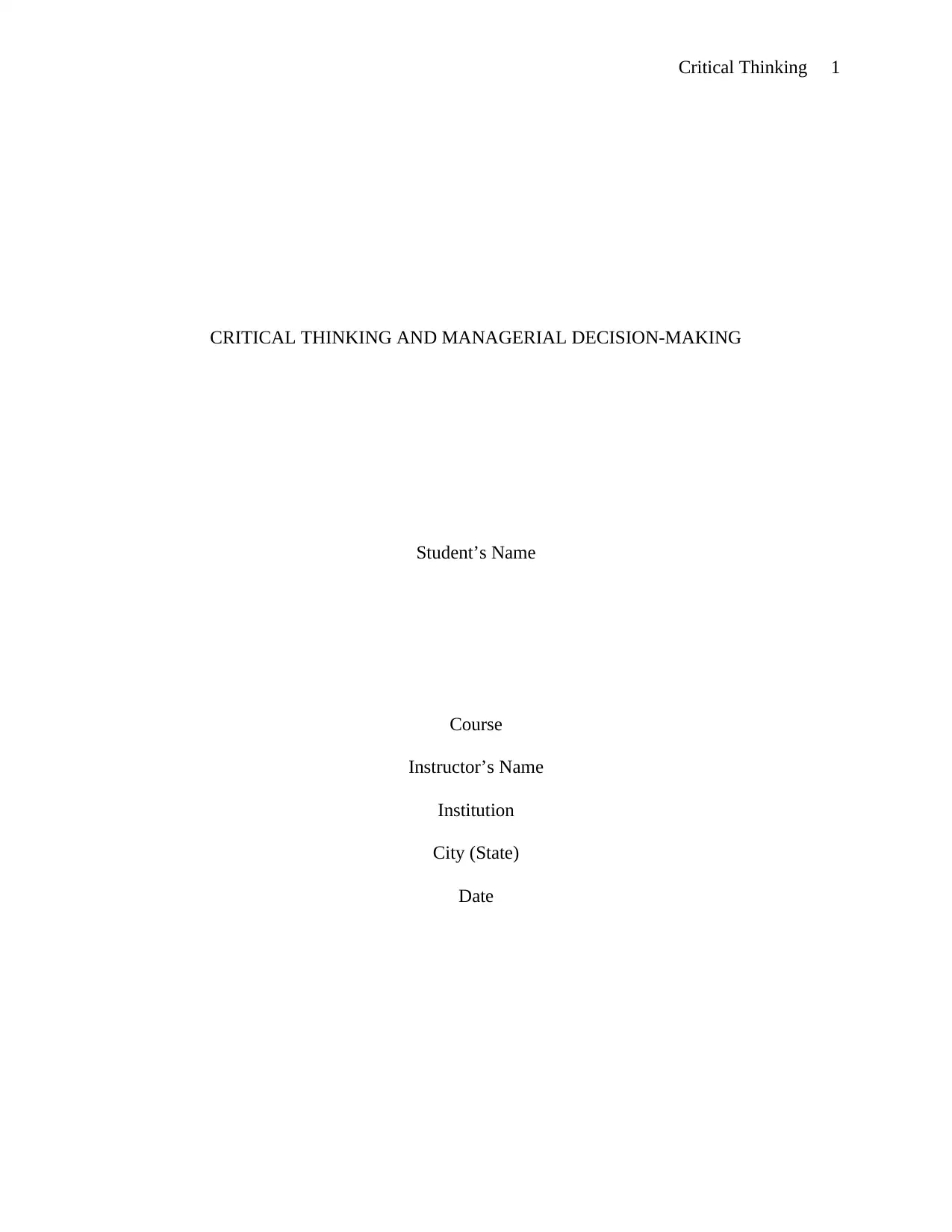
Critical Thinking 1
CRITICAL THINKING AND MANAGERIAL DECISION-MAKING
Student’s Name
Course
Instructor’s Name
Institution
City (State)
Date
CRITICAL THINKING AND MANAGERIAL DECISION-MAKING
Student’s Name
Course
Instructor’s Name
Institution
City (State)
Date
Secure Best Marks with AI Grader
Need help grading? Try our AI Grader for instant feedback on your assignments.
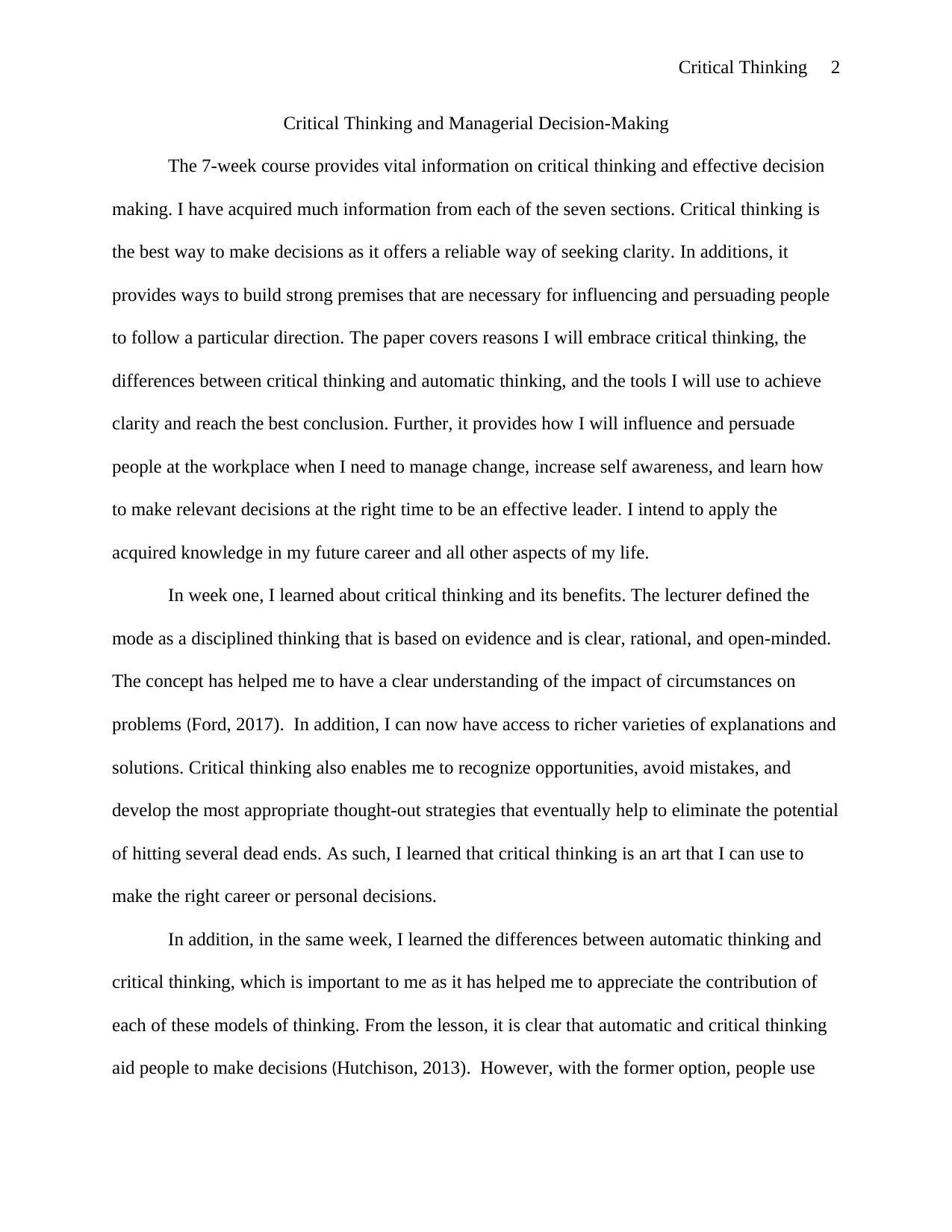
Critical Thinking 2
Critical Thinking and Managerial Decision-Making
The 7-week course provides vital information on critical thinking and effective decision
making. I have acquired much information from each of the seven sections. Critical thinking is
the best way to make decisions as it offers a reliable way of seeking clarity. In additions, it
provides ways to build strong premises that are necessary for influencing and persuading people
to follow a particular direction. The paper covers reasons I will embrace critical thinking, the
differences between critical thinking and automatic thinking, and the tools I will use to achieve
clarity and reach the best conclusion. Further, it provides how I will influence and persuade
people at the workplace when I need to manage change, increase self awareness, and learn how
to make relevant decisions at the right time to be an effective leader. I intend to apply the
acquired knowledge in my future career and all other aspects of my life.
In week one, I learned about critical thinking and its benefits. The lecturer defined the
mode as a disciplined thinking that is based on evidence and is clear, rational, and open-minded.
The concept has helped me to have a clear understanding of the impact of circumstances on
problems (Ford, 2017). In addition, I can now have access to richer varieties of explanations and
solutions. Critical thinking also enables me to recognize opportunities, avoid mistakes, and
develop the most appropriate thought-out strategies that eventually help to eliminate the potential
of hitting several dead ends. As such, I learned that critical thinking is an art that I can use to
make the right career or personal decisions.
In addition, in the same week, I learned the differences between automatic thinking and
critical thinking, which is important to me as it has helped me to appreciate the contribution of
each of these models of thinking. From the lesson, it is clear that automatic and critical thinking
aid people to make decisions (Hutchison, 2013). However, with the former option, people use
Critical Thinking and Managerial Decision-Making
The 7-week course provides vital information on critical thinking and effective decision
making. I have acquired much information from each of the seven sections. Critical thinking is
the best way to make decisions as it offers a reliable way of seeking clarity. In additions, it
provides ways to build strong premises that are necessary for influencing and persuading people
to follow a particular direction. The paper covers reasons I will embrace critical thinking, the
differences between critical thinking and automatic thinking, and the tools I will use to achieve
clarity and reach the best conclusion. Further, it provides how I will influence and persuade
people at the workplace when I need to manage change, increase self awareness, and learn how
to make relevant decisions at the right time to be an effective leader. I intend to apply the
acquired knowledge in my future career and all other aspects of my life.
In week one, I learned about critical thinking and its benefits. The lecturer defined the
mode as a disciplined thinking that is based on evidence and is clear, rational, and open-minded.
The concept has helped me to have a clear understanding of the impact of circumstances on
problems (Ford, 2017). In addition, I can now have access to richer varieties of explanations and
solutions. Critical thinking also enables me to recognize opportunities, avoid mistakes, and
develop the most appropriate thought-out strategies that eventually help to eliminate the potential
of hitting several dead ends. As such, I learned that critical thinking is an art that I can use to
make the right career or personal decisions.
In addition, in the same week, I learned the differences between automatic thinking and
critical thinking, which is important to me as it has helped me to appreciate the contribution of
each of these models of thinking. From the lesson, it is clear that automatic and critical thinking
aid people to make decisions (Hutchison, 2013). However, with the former option, people use
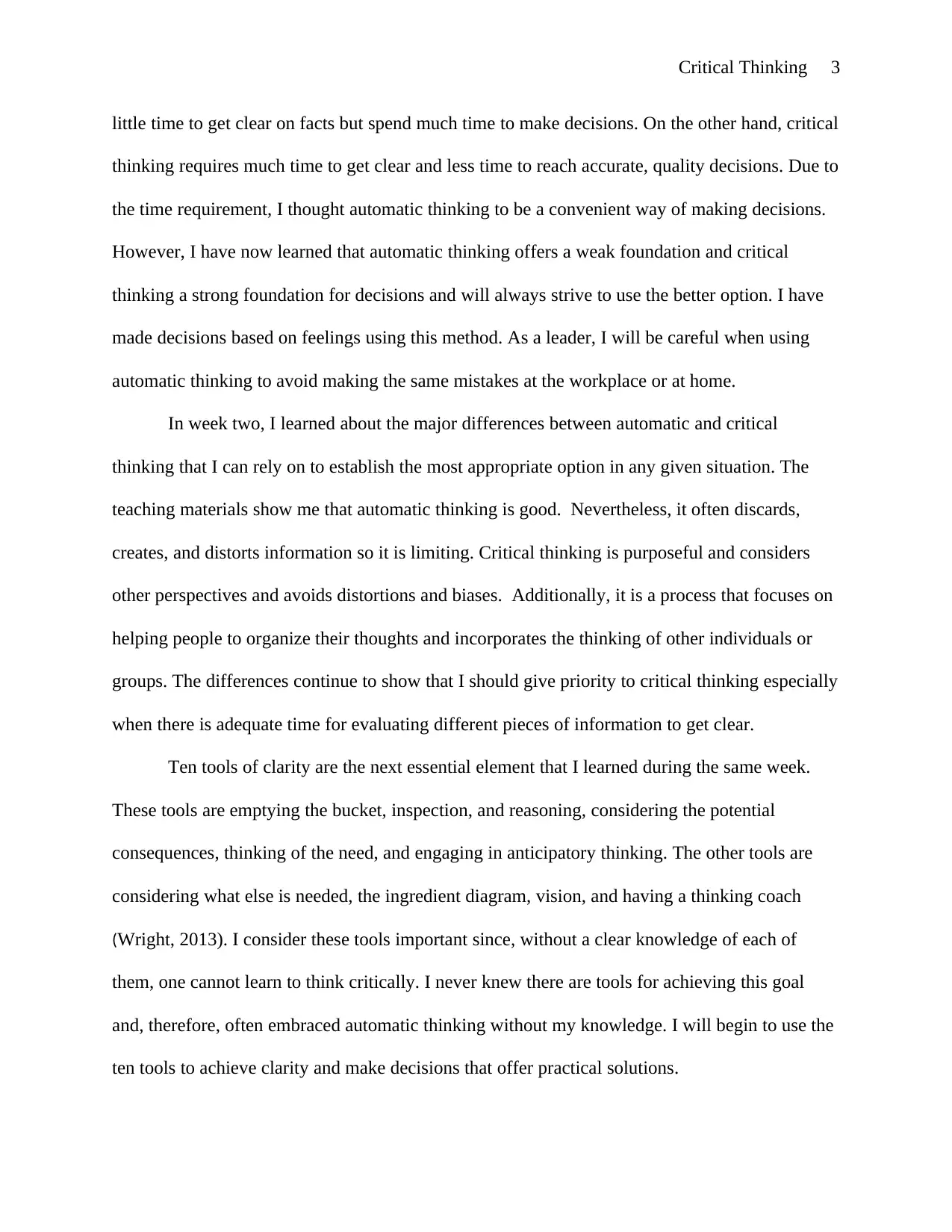
Critical Thinking 3
little time to get clear on facts but spend much time to make decisions. On the other hand, critical
thinking requires much time to get clear and less time to reach accurate, quality decisions. Due to
the time requirement, I thought automatic thinking to be a convenient way of making decisions.
However, I have now learned that automatic thinking offers a weak foundation and critical
thinking a strong foundation for decisions and will always strive to use the better option. I have
made decisions based on feelings using this method. As a leader, I will be careful when using
automatic thinking to avoid making the same mistakes at the workplace or at home.
In week two, I learned about the major differences between automatic and critical
thinking that I can rely on to establish the most appropriate option in any given situation. The
teaching materials show me that automatic thinking is good. Nevertheless, it often discards,
creates, and distorts information so it is limiting. Critical thinking is purposeful and considers
other perspectives and avoids distortions and biases. Additionally, it is a process that focuses on
helping people to organize their thoughts and incorporates the thinking of other individuals or
groups. The differences continue to show that I should give priority to critical thinking especially
when there is adequate time for evaluating different pieces of information to get clear.
Ten tools of clarity are the next essential element that I learned during the same week.
These tools are emptying the bucket, inspection, and reasoning, considering the potential
consequences, thinking of the need, and engaging in anticipatory thinking. The other tools are
considering what else is needed, the ingredient diagram, vision, and having a thinking coach
(Wright, 2013). I consider these tools important since, without a clear knowledge of each of
them, one cannot learn to think critically. I never knew there are tools for achieving this goal
and, therefore, often embraced automatic thinking without my knowledge. I will begin to use the
ten tools to achieve clarity and make decisions that offer practical solutions.
little time to get clear on facts but spend much time to make decisions. On the other hand, critical
thinking requires much time to get clear and less time to reach accurate, quality decisions. Due to
the time requirement, I thought automatic thinking to be a convenient way of making decisions.
However, I have now learned that automatic thinking offers a weak foundation and critical
thinking a strong foundation for decisions and will always strive to use the better option. I have
made decisions based on feelings using this method. As a leader, I will be careful when using
automatic thinking to avoid making the same mistakes at the workplace or at home.
In week two, I learned about the major differences between automatic and critical
thinking that I can rely on to establish the most appropriate option in any given situation. The
teaching materials show me that automatic thinking is good. Nevertheless, it often discards,
creates, and distorts information so it is limiting. Critical thinking is purposeful and considers
other perspectives and avoids distortions and biases. Additionally, it is a process that focuses on
helping people to organize their thoughts and incorporates the thinking of other individuals or
groups. The differences continue to show that I should give priority to critical thinking especially
when there is adequate time for evaluating different pieces of information to get clear.
Ten tools of clarity are the next essential element that I learned during the same week.
These tools are emptying the bucket, inspection, and reasoning, considering the potential
consequences, thinking of the need, and engaging in anticipatory thinking. The other tools are
considering what else is needed, the ingredient diagram, vision, and having a thinking coach
(Wright, 2013). I consider these tools important since, without a clear knowledge of each of
them, one cannot learn to think critically. I never knew there are tools for achieving this goal
and, therefore, often embraced automatic thinking without my knowledge. I will begin to use the
ten tools to achieve clarity and make decisions that offer practical solutions.
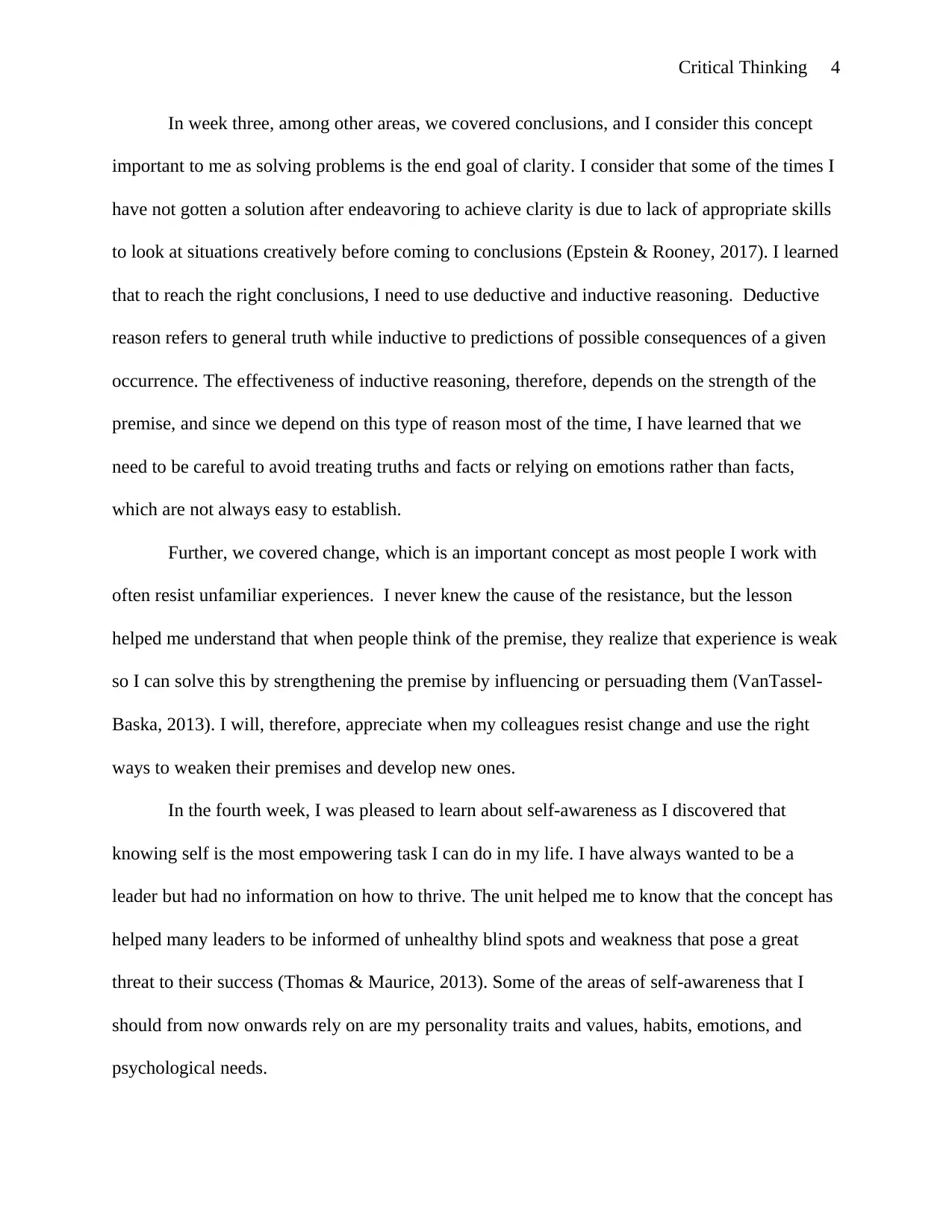
Critical Thinking 4
In week three, among other areas, we covered conclusions, and I consider this concept
important to me as solving problems is the end goal of clarity. I consider that some of the times I
have not gotten a solution after endeavoring to achieve clarity is due to lack of appropriate skills
to look at situations creatively before coming to conclusions (Epstein & Rooney, 2017). I learned
that to reach the right conclusions, I need to use deductive and inductive reasoning. Deductive
reason refers to general truth while inductive to predictions of possible consequences of a given
occurrence. The effectiveness of inductive reasoning, therefore, depends on the strength of the
premise, and since we depend on this type of reason most of the time, I have learned that we
need to be careful to avoid treating truths and facts or relying on emotions rather than facts,
which are not always easy to establish.
Further, we covered change, which is an important concept as most people I work with
often resist unfamiliar experiences. I never knew the cause of the resistance, but the lesson
helped me understand that when people think of the premise, they realize that experience is weak
so I can solve this by strengthening the premise by influencing or persuading them (VanTassel-
Baska, 2013). I will, therefore, appreciate when my colleagues resist change and use the right
ways to weaken their premises and develop new ones.
In the fourth week, I was pleased to learn about self-awareness as I discovered that
knowing self is the most empowering task I can do in my life. I have always wanted to be a
leader but had no information on how to thrive. The unit helped me to know that the concept has
helped many leaders to be informed of unhealthy blind spots and weakness that pose a great
threat to their success (Thomas & Maurice, 2013). Some of the areas of self-awareness that I
should from now onwards rely on are my personality traits and values, habits, emotions, and
psychological needs.
In week three, among other areas, we covered conclusions, and I consider this concept
important to me as solving problems is the end goal of clarity. I consider that some of the times I
have not gotten a solution after endeavoring to achieve clarity is due to lack of appropriate skills
to look at situations creatively before coming to conclusions (Epstein & Rooney, 2017). I learned
that to reach the right conclusions, I need to use deductive and inductive reasoning. Deductive
reason refers to general truth while inductive to predictions of possible consequences of a given
occurrence. The effectiveness of inductive reasoning, therefore, depends on the strength of the
premise, and since we depend on this type of reason most of the time, I have learned that we
need to be careful to avoid treating truths and facts or relying on emotions rather than facts,
which are not always easy to establish.
Further, we covered change, which is an important concept as most people I work with
often resist unfamiliar experiences. I never knew the cause of the resistance, but the lesson
helped me understand that when people think of the premise, they realize that experience is weak
so I can solve this by strengthening the premise by influencing or persuading them (VanTassel-
Baska, 2013). I will, therefore, appreciate when my colleagues resist change and use the right
ways to weaken their premises and develop new ones.
In the fourth week, I was pleased to learn about self-awareness as I discovered that
knowing self is the most empowering task I can do in my life. I have always wanted to be a
leader but had no information on how to thrive. The unit helped me to know that the concept has
helped many leaders to be informed of unhealthy blind spots and weakness that pose a great
threat to their success (Thomas & Maurice, 2013). Some of the areas of self-awareness that I
should from now onwards rely on are my personality traits and values, habits, emotions, and
psychological needs.
Secure Best Marks with AI Grader
Need help grading? Try our AI Grader for instant feedback on your assignments.
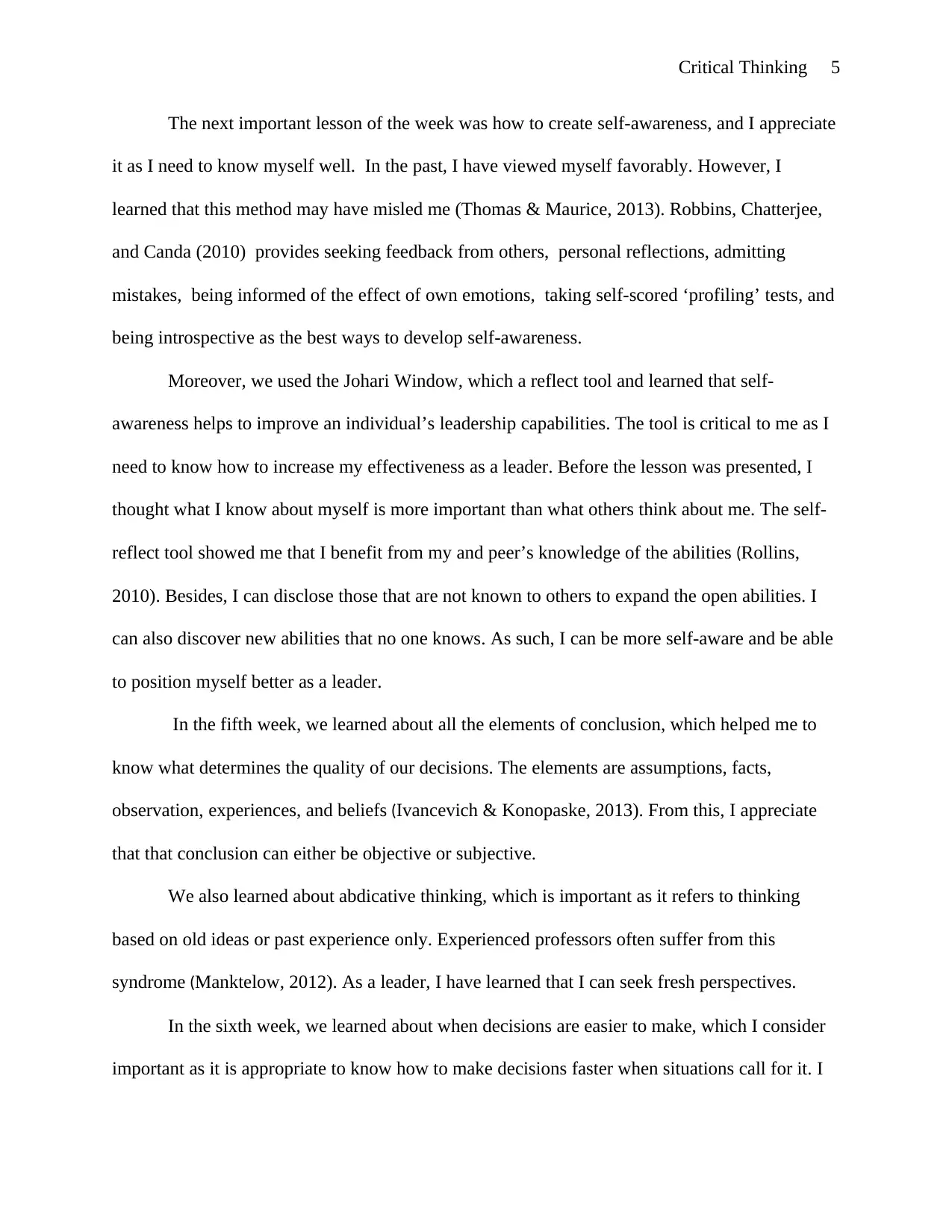
Critical Thinking 5
The next important lesson of the week was how to create self-awareness, and I appreciate
it as I need to know myself well. In the past, I have viewed myself favorably. However, I
learned that this method may have misled me (Thomas & Maurice, 2013). Robbins, Chatterjee,
and Canda (2010) provides seeking feedback from others, personal reflections, admitting
mistakes, being informed of the effect of own emotions, taking self-scored ‘profiling’ tests, and
being introspective as the best ways to develop self-awareness.
Moreover, we used the Johari Window, which a reflect tool and learned that self-
awareness helps to improve an individual’s leadership capabilities. The tool is critical to me as I
need to know how to increase my effectiveness as a leader. Before the lesson was presented, I
thought what I know about myself is more important than what others think about me. The self-
reflect tool showed me that I benefit from my and peer’s knowledge of the abilities (Rollins,
2010). Besides, I can disclose those that are not known to others to expand the open abilities. I
can also discover new abilities that no one knows. As such, I can be more self-aware and be able
to position myself better as a leader.
In the fifth week, we learned about all the elements of conclusion, which helped me to
know what determines the quality of our decisions. The elements are assumptions, facts,
observation, experiences, and beliefs (Ivancevich & Konopaske, 2013). From this, I appreciate
that that conclusion can either be objective or subjective.
We also learned about abdicative thinking, which is important as it refers to thinking
based on old ideas or past experience only. Experienced professors often suffer from this
syndrome (Manktelow, 2012). As a leader, I have learned that I can seek fresh perspectives.
In the sixth week, we learned about when decisions are easier to make, which I consider
important as it is appropriate to know how to make decisions faster when situations call for it. I
The next important lesson of the week was how to create self-awareness, and I appreciate
it as I need to know myself well. In the past, I have viewed myself favorably. However, I
learned that this method may have misled me (Thomas & Maurice, 2013). Robbins, Chatterjee,
and Canda (2010) provides seeking feedback from others, personal reflections, admitting
mistakes, being informed of the effect of own emotions, taking self-scored ‘profiling’ tests, and
being introspective as the best ways to develop self-awareness.
Moreover, we used the Johari Window, which a reflect tool and learned that self-
awareness helps to improve an individual’s leadership capabilities. The tool is critical to me as I
need to know how to increase my effectiveness as a leader. Before the lesson was presented, I
thought what I know about myself is more important than what others think about me. The self-
reflect tool showed me that I benefit from my and peer’s knowledge of the abilities (Rollins,
2010). Besides, I can disclose those that are not known to others to expand the open abilities. I
can also discover new abilities that no one knows. As such, I can be more self-aware and be able
to position myself better as a leader.
In the fifth week, we learned about all the elements of conclusion, which helped me to
know what determines the quality of our decisions. The elements are assumptions, facts,
observation, experiences, and beliefs (Ivancevich & Konopaske, 2013). From this, I appreciate
that that conclusion can either be objective or subjective.
We also learned about abdicative thinking, which is important as it refers to thinking
based on old ideas or past experience only. Experienced professors often suffer from this
syndrome (Manktelow, 2012). As a leader, I have learned that I can seek fresh perspectives.
In the sixth week, we learned about when decisions are easier to make, which I consider
important as it is appropriate to know how to make decisions faster when situations call for it. I

Critical Thinking 6
thought it is easier when the leader is alone. However, I learned that the leader should be the only
person involved in the process and will take responsibility for the outcome of the process to be
easier (Manktelow, 2012).
Besides, we covered factors that can influence the making of a better decision, which is
important to me as the speed and quality of decisions are all essential for most organizations. The
lesson helped us to know that understanding the need at hand is an essential element in this
process (DePoy & Gilson, 2012; Matthews & Lally, 2010). The benefits of the decision for all
parties and understanding of the sense of urgency also makes leaders prospered to embrace the
right thinking process.
The course has equipped me with skills that I need for my future career and life. I have
learned that critical thinking creates a stronger foundation for decisions than automatic thinking,
and so I will deliberately choose critical thinking always to make high-quality decisions.
However, in occasions when the risk of discarding, creating, and distorting information is little, I
will use automatic thinking so as to save time. Besides, since people often use inductive
reasoning instead of deductive reasoning. I will work on ways to reduce its negative impacts.
Inductive reasoning is based on experience, emotions, beliefs, and assumptions, and, therefore,
may not be perfect. I will, for that reason, endeavor to make decisions based on the strength of
premises. Further, since people at the workplace try to resist change, I will use influence and
persuasion to weakened their premises and create new, strong premises and eventually win many
of them. I will also use the Johari Window to increase myself awareness, which will help me to
position myself correctly as a leader. In addition, I will always seek fresh perspectives to avoid
abdicative reasoning that troubles many experienced professionals. In this way, I will be able to
thought it is easier when the leader is alone. However, I learned that the leader should be the only
person involved in the process and will take responsibility for the outcome of the process to be
easier (Manktelow, 2012).
Besides, we covered factors that can influence the making of a better decision, which is
important to me as the speed and quality of decisions are all essential for most organizations. The
lesson helped us to know that understanding the need at hand is an essential element in this
process (DePoy & Gilson, 2012; Matthews & Lally, 2010). The benefits of the decision for all
parties and understanding of the sense of urgency also makes leaders prospered to embrace the
right thinking process.
The course has equipped me with skills that I need for my future career and life. I have
learned that critical thinking creates a stronger foundation for decisions than automatic thinking,
and so I will deliberately choose critical thinking always to make high-quality decisions.
However, in occasions when the risk of discarding, creating, and distorting information is little, I
will use automatic thinking so as to save time. Besides, since people often use inductive
reasoning instead of deductive reasoning. I will work on ways to reduce its negative impacts.
Inductive reasoning is based on experience, emotions, beliefs, and assumptions, and, therefore,
may not be perfect. I will, for that reason, endeavor to make decisions based on the strength of
premises. Further, since people at the workplace try to resist change, I will use influence and
persuasion to weakened their premises and create new, strong premises and eventually win many
of them. I will also use the Johari Window to increase myself awareness, which will help me to
position myself correctly as a leader. In addition, I will always seek fresh perspectives to avoid
abdicative reasoning that troubles many experienced professionals. In this way, I will be able to
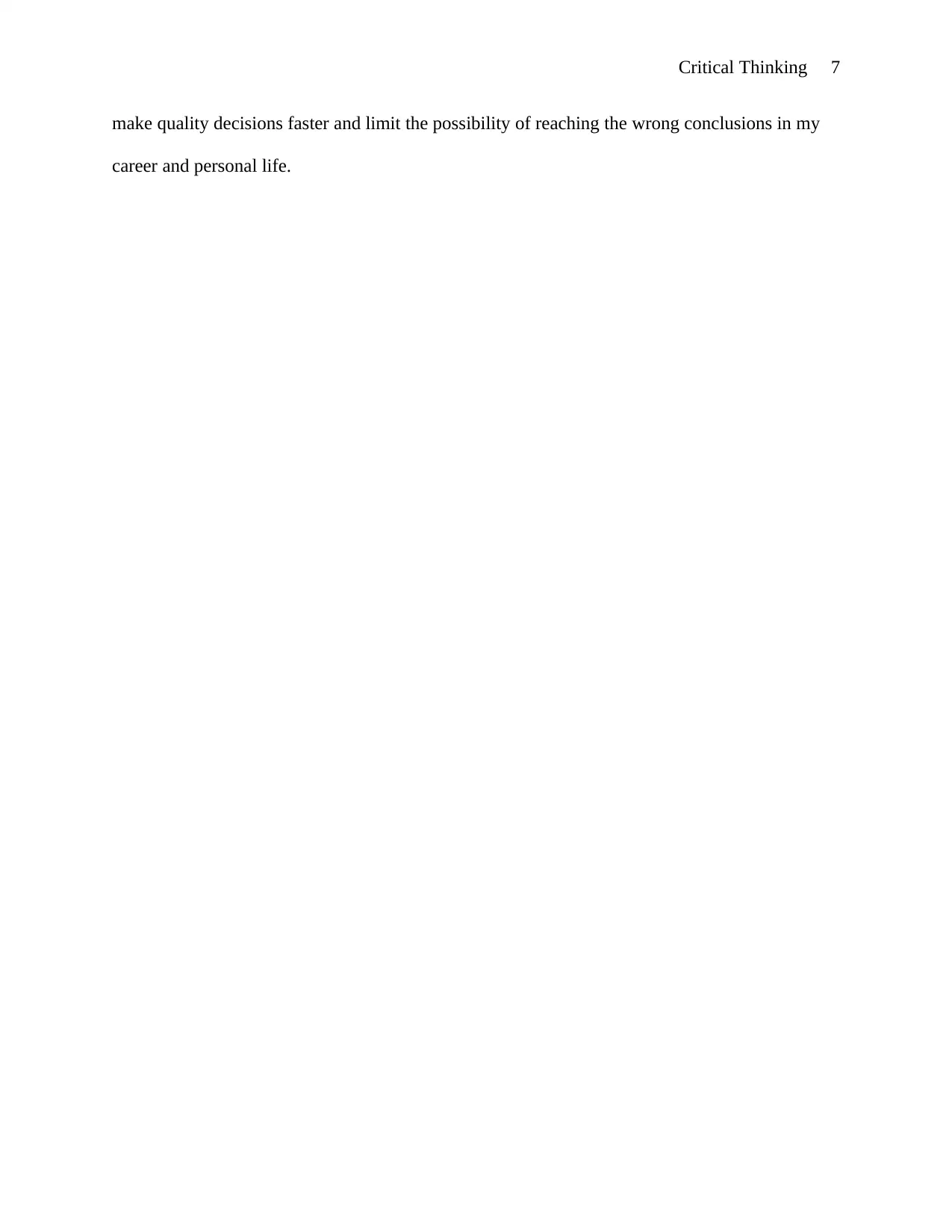
Critical Thinking 7
make quality decisions faster and limit the possibility of reaching the wrong conclusions in my
career and personal life.
make quality decisions faster and limit the possibility of reaching the wrong conclusions in my
career and personal life.
Paraphrase This Document
Need a fresh take? Get an instant paraphrase of this document with our AI Paraphraser
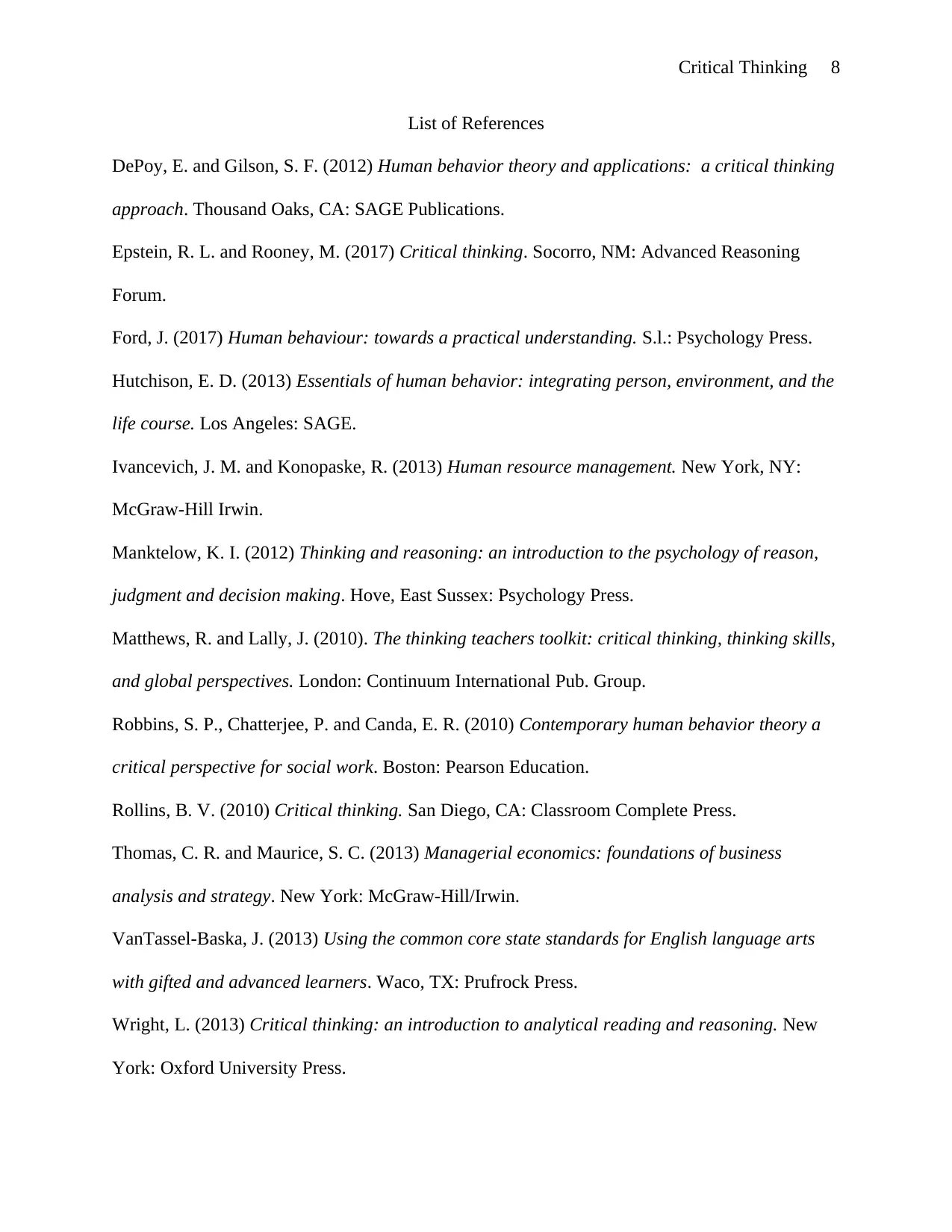
Critical Thinking 8
List of References
DePoy, E. and Gilson, S. F. (2012) Human behavior theory and applications: a critical thinking
approach. Thousand Oaks, CA: SAGE Publications.
Epstein, R. L. and Rooney, M. (2017) Critical thinking. Socorro, NM: Advanced Reasoning
Forum.
Ford, J. (2017) Human behaviour: towards a practical understanding. S.l.: Psychology Press.
Hutchison, E. D. (2013) Essentials of human behavior: integrating person, environment, and the
life course. Los Angeles: SAGE.
Ivancevich, J. M. and Konopaske, R. (2013) Human resource management. New York, NY:
McGraw-Hill Irwin.
Manktelow, K. I. (2012) Thinking and reasoning: an introduction to the psychology of reason,
judgment and decision making. Hove, East Sussex: Psychology Press.
Matthews, R. and Lally, J. (2010). The thinking teachers toolkit: critical thinking, thinking skills,
and global perspectives. London: Continuum International Pub. Group.
Robbins, S. P., Chatterjee, P. and Canda, E. R. (2010) Contemporary human behavior theory a
critical perspective for social work. Boston: Pearson Education.
Rollins, B. V. (2010) Critical thinking. San Diego, CA: Classroom Complete Press.
Thomas, C. R. and Maurice, S. C. (2013) Managerial economics: foundations of business
analysis and strategy. New York: McGraw-Hill/Irwin.
VanTassel-Baska, J. (2013) Using the common core state standards for English language arts
with gifted and advanced learners. Waco, TX: Prufrock Press.
Wright, L. (2013) Critical thinking: an introduction to analytical reading and reasoning. New
York: Oxford University Press.
List of References
DePoy, E. and Gilson, S. F. (2012) Human behavior theory and applications: a critical thinking
approach. Thousand Oaks, CA: SAGE Publications.
Epstein, R. L. and Rooney, M. (2017) Critical thinking. Socorro, NM: Advanced Reasoning
Forum.
Ford, J. (2017) Human behaviour: towards a practical understanding. S.l.: Psychology Press.
Hutchison, E. D. (2013) Essentials of human behavior: integrating person, environment, and the
life course. Los Angeles: SAGE.
Ivancevich, J. M. and Konopaske, R. (2013) Human resource management. New York, NY:
McGraw-Hill Irwin.
Manktelow, K. I. (2012) Thinking and reasoning: an introduction to the psychology of reason,
judgment and decision making. Hove, East Sussex: Psychology Press.
Matthews, R. and Lally, J. (2010). The thinking teachers toolkit: critical thinking, thinking skills,
and global perspectives. London: Continuum International Pub. Group.
Robbins, S. P., Chatterjee, P. and Canda, E. R. (2010) Contemporary human behavior theory a
critical perspective for social work. Boston: Pearson Education.
Rollins, B. V. (2010) Critical thinking. San Diego, CA: Classroom Complete Press.
Thomas, C. R. and Maurice, S. C. (2013) Managerial economics: foundations of business
analysis and strategy. New York: McGraw-Hill/Irwin.
VanTassel-Baska, J. (2013) Using the common core state standards for English language arts
with gifted and advanced learners. Waco, TX: Prufrock Press.
Wright, L. (2013) Critical thinking: an introduction to analytical reading and reasoning. New
York: Oxford University Press.
1 out of 8
Related Documents
Your All-in-One AI-Powered Toolkit for Academic Success.
+13062052269
info@desklib.com
Available 24*7 on WhatsApp / Email
![[object Object]](/_next/static/media/star-bottom.7253800d.svg)
Unlock your academic potential
© 2024 | Zucol Services PVT LTD | All rights reserved.




